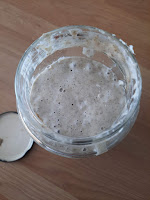I've always been interested in baking bread and I recently took on the endeavour of baking sourdough. Immediately, I started to hear how difficult sourdough bread is to bake due to the the time consuming aspect of baking the bread properly. Even before this journey, I knew that bread-bakers always attributed sourdough to a very difficult bread. So, I started this journey with my guard up, expecting to make many mistakes that would result in uneatable bread.
Guess what. They lied.
I'm not saying it was incredibly easy, there are plenty of lessons I've learned through my mistakes. But those mistakes do not mark a difficulty for me, they mark my accomplishments. I've made mistakes I never thought I could make through my journey of baking sourdough, but they taught me valuable lessons and I don't regret a single mistake I made.
I decided to dust off my blog after taking to a friend about sourdough, and all she had heard about it was that it was the most difficult thing that the baking world has to offer, and to begin a journey down that road would mean inviting chaos and heartbreak into your life. (In the shape of bread, of course.) I, having heard similar warnings before I started baking bread, tried to tell her about the joys of baking your own bread and experimenting to make unique bread, but she was insistent that it would be too difficult and that she's not ready for it. So, I've decided to write about my sourdough journey to demonstrate how easy the bread making process can be, despite its hurdles.
I followed the recipe from The All-Purpose Baker's Companion from the King Arthur Baking Company bread recipe book. As they instructed, I used a large jar to start my sourdough starter. I found an empty jar of olives I got from Tesco, cleaned it out, and started the sourdough starter process.
I needed whole rye and all-purpose flour to start the sourdough starter process, which took seven days to fully complete. Each day, I needed to discard half a cup of the started to feed it again daily throughout the week. The first day required 1 cup of whole rye flour and 1/2 cup of cool water, which I mixed thoroughly and left it to ferment for 24 hours in 70 degrees Fahrenheit or 21 degrees Celsius. Overnight, the starter fermented and almost doubled in size. The next day, I discarded half a cup of the started, then "fed" it for the first time with all-purpose flour. From the second day forward, I have fed the starter with all-purpose flour only. Over the next week I discarded the starter and fed it with flour and water everyday (the same measurements as previously mentioned) and waited for it to ferment over the week. The pictures show the fermentation of the sourdough starter show how the starter began to bubble by the week's end, which indicated that it was capable of making it's own gas and rising by itself in the matter of a few hours.
After the starter was ready to go, it was time to start baking my own bread. I was trying to make the bread into the class or traditional "bread shape", which didn't yield the best results for me as the pictures below show. I also added too much water into the dough which made it difficult to score the bread. This was one of my first mistakes with sourdough, from which I learned that the recipe is not to be questioned, and must be followed to the t.









.jpg)
Comments
Post a Comment